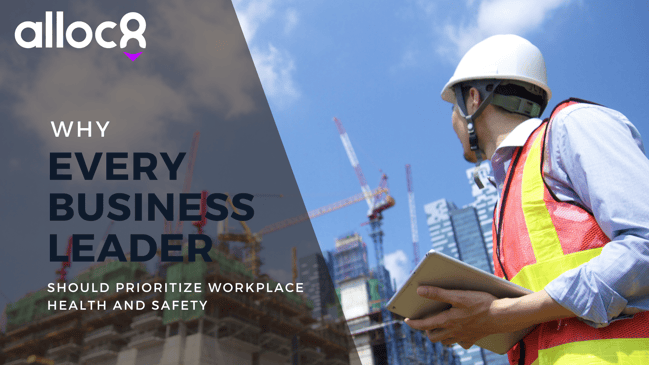The Impacts of Poor Safety Culture and Compliance on Your Team and Organisation
Posted by Alloc8, Mon, May 15, 2023

Workplace health and safety may not be the most exciting topic, but it is undoubtedly important. Every leader in your business should care about it, and here's why. This article will explore what can happen when a safety culture is not created and supported and safety compliance is not a priority. We will also discuss the far-reaching impacts that this can have on your team and organisation, particularly in the traffic and labour hire industries where Alloc8 specialises in workforce management.
Maintaining a safe and compliant workplace is not just the responsibility of the OH&S Officer or the HR Manager alone. It needs to be prioritised by every leader in the business, so they can lead by example and pass these values on to their team members. In this way, everyone can cooperate in building a truly safe workplace where safety is top of mind, safety processes are shared and applied, and safety feedback from every team member is encouraged and used to support continuous improvement.
A poor safety culture can hinder your compliance efforts. When you work hard to put important policies in place, you want everyone in the business to not just accept them but actually follow them. Otherwise, your efforts could be rendered futile. Maintaining a culture where safety is taken seriously and prioritised by everyone in the business helps ensure safety policies are adhered to.
This starts with all leaders in the business leading by example and helping their team to follow suit. Studies examining the relationship between safety culture and staff injuries found managers' attitudes towards safety were the biggest predictor of workplace incidents.
We also know that organisations are more likely to see workplace incidents occur when process compliance across the business is poor. So, making policy delivery and acceptance as straightforward and convenient as possible is key.
If you’re reading this, chances are you already know the importance of prioritising workplace health and safety. But, if you need pointers to help others in the business, take it as seriously as you do; read on.
A poor safety culture can jeopardise your people's well-being and morale. Okay, so this may be obvious, but the safety risks go much further than just the individual affected.
Before we even consider the financial and legal ramifications of not prioritising WHS compliance in your organisation, the main concern is looking after your people and ensuring they get home safely from work each day.
A serious workplace injury (or worse) obviously takes a huge toll not just on the individual affected and their family, but the ripple effect continues beyond this, spreading low morale and inciting safety concerns across their peers too.
Naturally, this can lead to absenteeism, losses in performance and efficiency, and ultimately to attrition as people seek safer jobs elsewhere.
A poor safety culture will expose your business to risk. Beyond this, leaving gaps in your compliance can have serious legal or regulatory ramifications.
But just how bad can it be?
Multiple states in Australia now have industrial manslaughter laws in place, holding businesses liable if it's found their gross negligence led to death. In Queensland, for example, the offence carries a maximum penalty of 20 years imprisonment for senior officers and $10 million for body corporates.
Earlier this month, industrial manslaughter charges were handed down to a company and its directors under section 34C of the Work Health and Safety Act 2011 (Qld). The auto recycling business was found to have negligently caused death after one of their forklifts reversed into a pedestrian.
By keeping health and safety compliance at the top of organisational priorities, the opportunity for events like these to occur can be diminished.
A poor safety culture can impact your bottom line. The cost of lost productivity increased sick leave, and decreased shareholder value can be significant. Building a culture of compliance in your organization is a proactive investment in building a productive and profitable workplace.
At Alloc8, we know how important workplace health and safety are. That's why we're committed to helping businesses prioritise safety and compliance in their workforce management. Alloc8's end-to-end workflows mitigate risks and assist with compliance by providing a comprehensive workforce management system that enables businesses to easily track and manage compliance requirements related to workplace health and safety (WHS) and other regulatory standards. This includes features such as real-time monitoring of worker certifications and qualifications, automated rostering to ensure the right workers are assigned to the right jobs, and detailed reporting and analytics to ensure compliance is being met across the organization.
Alloc8 also provides businesses with access to a range of WHS resources and training modules, helping to ensure that workers are fully trained and equipped to operate safely and competently. This can help businesses avoid costly fines and legal penalties associated with non-compliance while reducing the risk of workplace incidents and injuries. By prioritising compliance and safety, businesses can build a strong safety culture, boost morale and productivity, and enhance their reputation as responsible and reliable employers.
Ready to prioritise workplace health and safety and improve compliance in your organization? Let us help. Our workforce management solutions are designed to streamline compliance processes and empower every leader in your business to make safety a top priority. Contact us today to book a full-product demo.
Topics: workplace safety, health and safety, workforce management, industry news